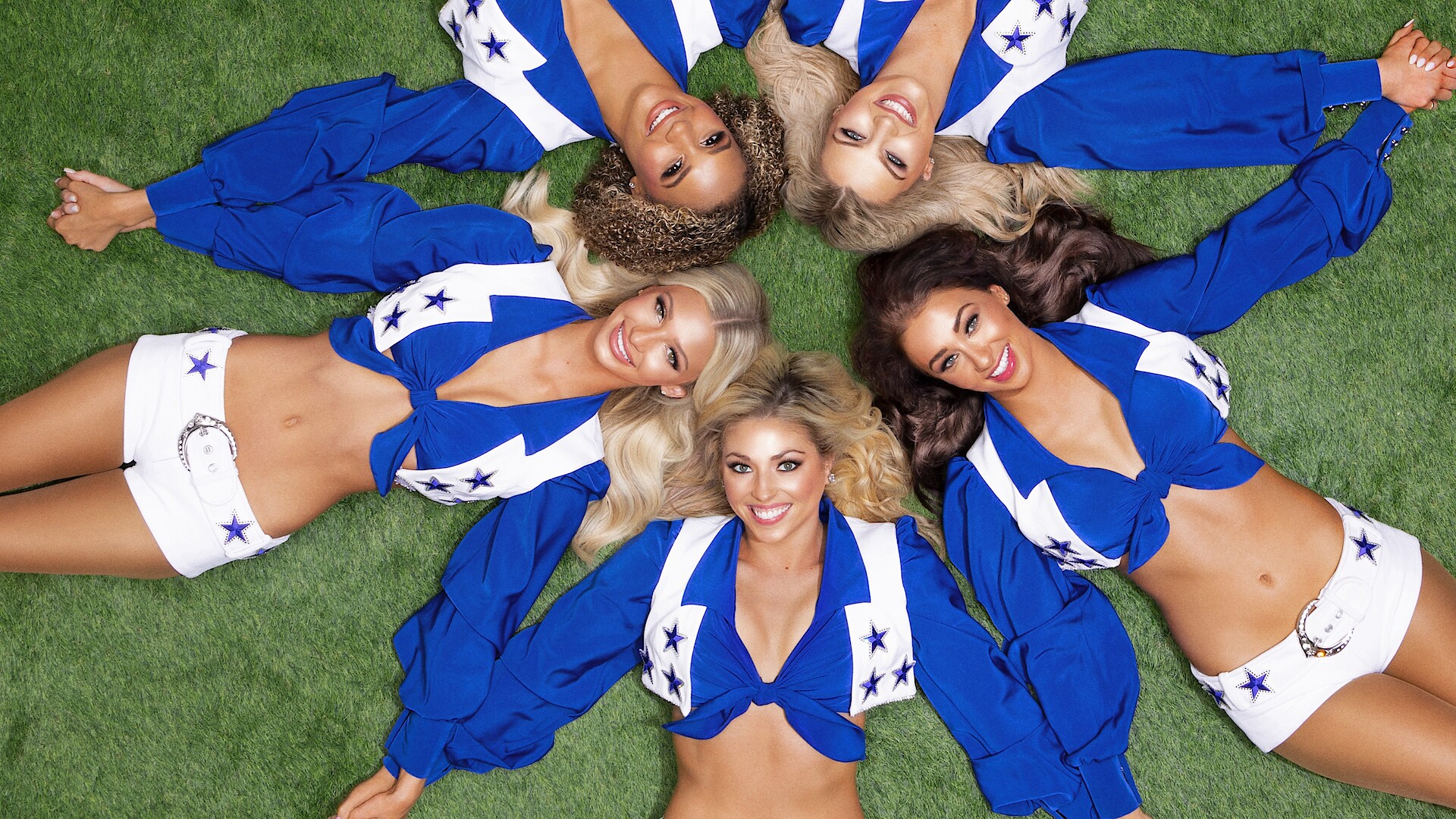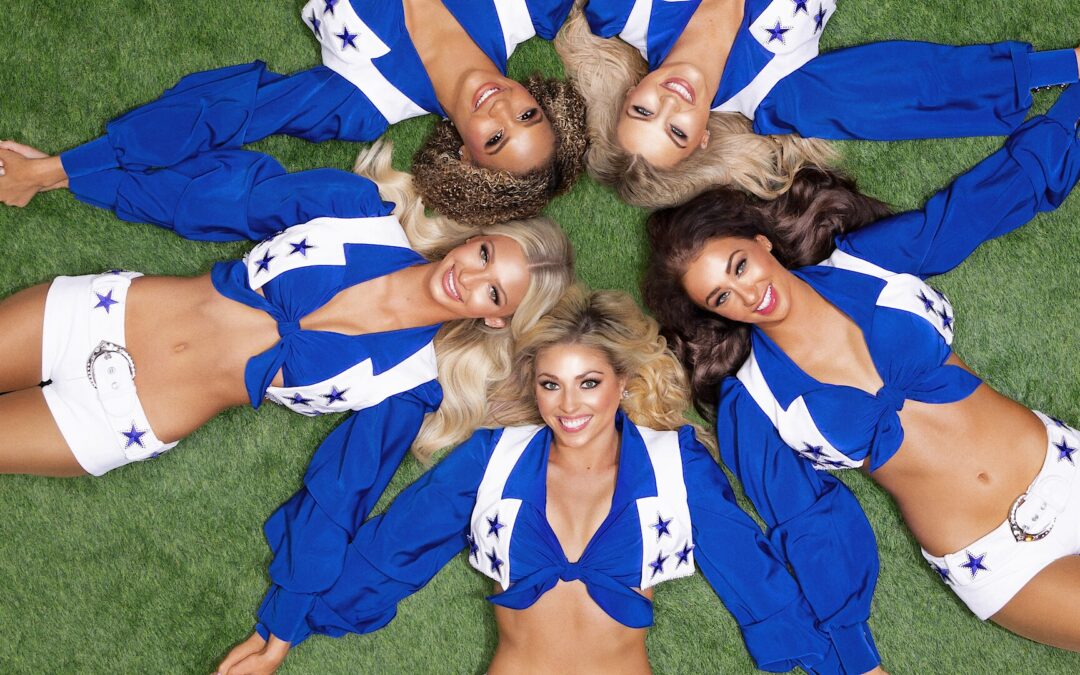Inside The Dallas Cowboys pay scandal
The cheerleaders have been fighting for fair pay for generations.
Words by Nikki Peach

Anyone who has watched America’s Sweethearts: Dallas Cowboys Cheerleaders will know it’s nothing if not a team effort. The cheerleaders are not only athletes in their own right and a crucial part of the NFL season, but they are now reality stars too.
The series follows the 36 cheerleaders, who are all studio-trained dancers, through team selection to their daily life in the squad. It also sheds light on their gruelling training schedules – overlooked in comparison to their NFL counterparts – which sees them rehearse two to three times per week for two to three hours at a time from July to the end of the Cowboys season. This amounts to a 40-hour per week commitment, before you consider home games, promotional appearances and filming for the Netflix show. Most of the cheerleaders also work full-time jobs.
It’s hardly surprising, then, that the DCC joined together to demand fairer pay. Now that season two of the hit Netflix show has finally arrived, the Cowboys stars were pleased to confirm that they’ve received a 400% pay increase. ‘Our efforts were heard, and they wanted to give us a raise,’ explained Megan McElaney, who has been on the team for four years. She described the salary bump as ‘life-changing’.
What did the Dallas Cowboys Cheerleaders earn before?
America’s Sweethearts: Dallas Cowboys Cheerleaders did not disclose what the cheerleaders earned before the pay rise, or what they now earn either. In 2022, NBC Sports Boston reported that NFL cheerleaders typically earn $150 (£112) per game or an annual salary of about $22,500 (£16.8k).
However, Jada McLean, who used to cheer for the Cowboys team told The New York Times she used to make $15 (£11.20) per hour despite being a five-year veteran. In the 2010s, the DCC reportedly earned up to $200 (£149.40) per game but would train for free. If McLean’s salary was standardised, it’s possible the cheerleaders now earn in the region of $75 (£56) per hour for training. The new contracts have also changed pay structure for game day and other appearances. The franchise has not confirmed McLean’s statement.
‘They’re not paid a lot,’ admitted Dallas Cowboys brand officer Charlotte Jones Anderson in season one, adding that their work was fuelled by a ‘passion for dance’. She claimed being part of the DCC was ‘about being a part of something bigger than themselves. They have a chance to feel like they’re valued, that they’re special and that they are making a difference.’
‘Our efforts were heard.’ – Megan McElaney
Have the Dallas Cowboys Cheerleaders asked for more money before?
In 2017, the cheerleaders brought a federal lawsuit against the Cowboys which alleged they were paid $8 (£5.90) an hour. Of course, this was well below the $23 (£17) an hour rate that is currently considered ‘living wage’ in Dallas. It’s also significantly less than the reported $65k (£48k) annual wage of the Cowboys’ male mascot, Rowdy.
Unfortunately, low pay has been an issue within the squad since it was founded. Not least because the Cowboys franchise reportedly has a net worth of $10 billion, but many of the NFL stars are earning north of $50 million per season.
What’s perhaps most alarming is that the cheerleaders’ rate was $15 (£11) per game in 1972, the year the team won the Super Bowl. 20 years later, the DCC were allegedly earning the same amount, albeit per hour instead of per game.
By the 1980s, thousands of women were auditioning to be part of the squad when the team was at its peak, but the fee remained the same. Reflecting on the cheerleaders’ wages in Texas Monthly in the mid 2010s, former DCC director Suzanne Mitchell said, ‘It wasn’t enough to pay for their pantyhose, for goodness sake. In order to audition, they had to either be a full-time student, a wife and a mother, or hold a full-time job.’
That decade saw the cheerleaders realise they were being given a measly deal and start to lobby for better pay. However, under the guidance of the general manager Tex Schramm, the Dallas Cowboys organisation turned them down. ‘They saw us as fluff,’ said former cheerleader Dana Presley Killmer.
Do the Dallas Cowboys cheerleaders still have other jobs?
In season one, audiences watched the DCC squad navigate the intensive training programme whilst working full-time jobs. One cheerleader on the show worked as an orthodontist and another, Kelcey Wetterberg, worked as a paediatric nurse. While Armani Latimer, the group leader, was also a billing director at a law firm and was working towards applying for law school. Brooklyn Davis would also work as a sales manage for the National Medal of Honour Museum when she wasn’t in training. Other jobs include a cosmetic associate, an accountant, a financial planner, a Pilates instructor and running an online fashion brand.
‘We’re all working so many hours outside of [DCC], just trying to compensate financially,’ as McLean put it. ‘It’s really hard to work two jobs, but also give your full commitment to DCC while you’re here.’ The toll this took on their personal lives and physical health was evident in season one of the Netflix show. Now that they have increased their pay but such a sizeable amount, it is unclear if the cheerleaders will still have to juggle as much to make ends meet.
What do the Dallas Cowboys NFL players earn?
Unsurprisingly given the bleak commonality of the gender pay gap, especially in sports, several Dallas Cowboys players are on multi-million-dollar contracts. This includes quarterback Dak Prescott, who reportedly earned $60 million (£44.8m) last season.
As of September 2024, the average salary for an NFL player is around £2.8 million (£2m). However, the median average is reportedly lower and is dragged up by the fee of star players like quarterbacks.
Where can I watch season two of America’s Sweethearts: Dallas Cowboys Cheerleaders?
Season two of the hit Dallas reality show is available to stream on Netflix.
Photo: Netflix

